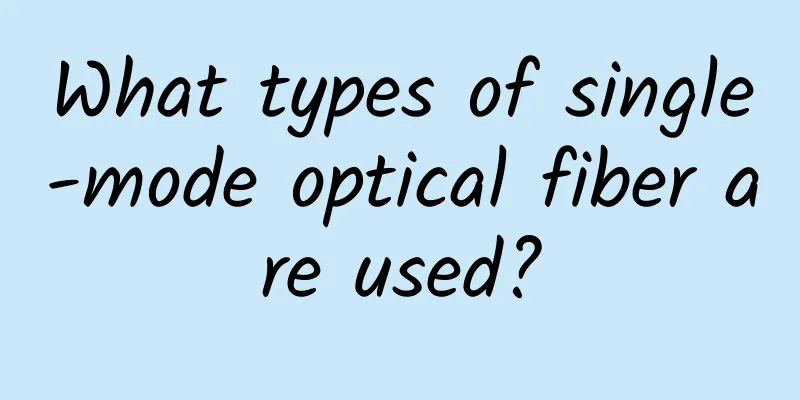What types of single-mode optical fiber are used?

What is single mode fiber?In fiber optic technology, single-mode fiber (SMF) is an optical fiber designed to transmit a single ray of light or single-mode light as a single propagating carrier. Typically, single-mode cables have a narrow core diameter of 8 to 10µm (micrometers) and can propagate at wavelengths of 1310nm and 1550nm. In single-mode fiber, all signals travel directly down the middle without bouncing off the edges (blue line in the image below), eliminating any distortion that could result from overlapping light pulses. Signals such as cable TV, internet and telephone are usually carried by single-mode optical fibers that are twisted together to form a giant bundle. Single-mode fiber is the best choice for transmitting data over long distances, such as 100 kilometers (60 miles), because of the low signal attenuation caused by its single mode. Single-mode fiber types: OS1 and OS2As we all know, multimode optical fiber is generally divided into OM1, OM2, OM3, OM4 and OM5 optical fiber types. When it comes to single-mode optical fiber types, it can be divided into OS1 and OS2 optical fibers, both of which are SMF optical fiber specifications. OS1 and OS2 are standard single-mode optical cables, using 1310nm and 1550nm wavelengths, respectively, with maximum attenuation of 1dB/km and 0.4dB/km, respectively. OS1 fiber is a tightly buffered cable designed for indoor applications with a maximum distance of 10 kilometers, such as campuses or data centers. OS2 fiber is a loose tube cable designed for outdoor applications such as street and underground with a maximum distance of up to 200 km. Both OS1 and OS2 fiber cables support Gigabit and 10G Ethernet links. In addition, OS2 fiber can support 40G and 100G Ethernet links. What are the advantages and disadvantages of single-mode fiber?Generally, the advantages and disadvantages of single-mode optical fiber are relative concepts and are usually compared with multimode optical fiber. Advantages of single-mode fiberSingle-mode fiber distance: Single-mode fiber supports greater distances than multimode fiber due to its lower attenuation. For example, multimode fiber can usually reach a few hundred meters, while SM fiber has the potential to reach 200 kilometers. Bandwidth Capacity: Single-mode fiber optic cables offer higher bandwidth than multimode fiber optic cables. Data dispersion: Single-mode optical fiber transmits only one mode of light and does not produce mode dispersion. Single-mode fiber speed: Single-mode fiber does not have modal dispersion, modal noise, and other effects of multimode transmission. Therefore, it can transmit signals at higher speeds than multimode fiber and up to 50 times the transmission distance. Disadvantages of single-mode fiberTighter tolerances required: Coupling light into single-mode fiber is more difficult than coupling into multimode fiber because the fiber core diameter inside the SMF is smaller. The smaller core (8-10µm) requires tighter tolerances than coupling light into the larger core (62.5/50µm) of a multimode fiber. Higher cost: Single-mode fiber components and equipment are more expensive than multimode fiber. Multimode fiber can support multiple light modes, which is more expensive than single-mode fiber. However, in terms of equipment, single-mode fiber equipment is more expensive than multimode fiber equipment because single-mode fiber usually uses solid-state laser diodes. More demanding technology: Manufacturing and processing SMF is more difficult than MMF. Applications of Single Mode Fiber Optic CableThe applications of single-mode optical fiber can be divided into the following four main situations according to different categories. In addition, single-mode optical fiber is widely used in the manufacture of optical fiber components or equipment such as single-mode optical fiber adapters, optical fiber attenuators, pigtails and jumpers. For example, indoor single-mode optical cables can be made into optical fiber pigtails or jumpers to connect with single-mode optical fiber equipment. SummaryIn summary, single-mode fiber is necessary and effective for network construction in different situations. Using single-mode fiber cables is the best way to eliminate modal dispersion over long distances. Therefore, using single-mode fiber in backbone systems is very popular. |
<<: How Fiber Optic Cable Helps Data Centers Save Money
>>: Security and Reliability of Critical Infrastructure Fiber Optic Networks
Recommend
Misaka: $44/year KVM-2GB/32G NVMe/2TB/Germany (optional CN2)
Misaka is a Chinese merchant (the same company as...
Understanding the new features of HTTP/2 and HTTP/3 (recommended)
Compared with HTTP/1.1, HTTP/2 can be said to hav...
Can the Internet of Things drive the deployment of IPv6?
IPv6 has features that IPv4 lacks, which makes it...
How do operators grasp the pulse of the cloud computing market in the 5G era?
On June 6, 2019, the Ministry of Industry and Inf...
It has been almost three years since number portability was implemented. Who is the winner among the three major operators?
Since the three major operators in my country occ...
V5.NET: Korea/Hong Kong dedicated server 30% off monthly payment starting from 325 yuan
V5.NET is a business that provides independent se...
5G development: Don’t be afraid of the clouds blocking your view
Although some voices that are pessimistic about 5...
How to protect data in an increasingly insecure environment?
Protecting data is becoming increasingly difficul...
What is the difference between Industrial IoT and Consumer IoT?
Much has been written about the consumer Internet...
Analyzing the technology behind short videos and reopening the battle against CDN
If the live streaming industry was booming in 201...
DediPath Spring Promotion: 35% off on all VPS, dedicated servers starting at $49/month, Los Angeles/Dallas/Seattle/New York data centers
DediPath has just launched a spring promotion, of...
BudgetVM high-defense dedicated server 50% off for the first month, 1Gbps unlimited traffic, 5 computer rooms starting from $41.94
BudgetVM is still offering a 50% discount on the ...
How do we correctly interrupt a thread that is executing? ?
[[358852]] The author has developed a simple, sta...
If operators want to make profits, they should eliminate 4G packages first.
[[346837]] After 2019, the first year of 5G, and ...
How 5G will improve hyper-connectivity in smart cities
[[343220]] 5G is the next big thing in the techno...









